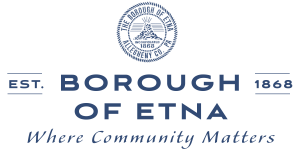© All rights reserved. The Borough of Etna
Pine Creek Watershed
Stormwater Management Ordinance
Please see the Borough Stormwater Management Ordinance – No 1378. This ordinance is applicable during any new construction and/or new development project, within the Borough of Etna. There are also guidelines dealing with redevelopment, grading and other aspects of development that can affect storm water in our community. It also limits were new development can happen within our community. This ordinance provides for a fifty foot buffer along any watercourse that is within our Community or surrounds our community. It is important in Etna Borough that we pay close attention to storm water management. Being the community at the bottom of the Pine Creek Watershed and Sewershed, we have many issues with storm water problems. Sewer capacity within the combined sewer system can be exceeded during heavy rain events, causing overflows to our streams is one of those issues. Localized flooding is another issue we face. Proper stormwater management regulations can help address these issues. As can a more proactive approach to storm water source control, which the Borough is actively pursuing where appropriate.
Wet Weather Public Outreach Campaign Ads

Additional Water Quality Efforts to Improve Pine Creek & Allegheny River
Etna Borough is a COMBINED SEWER COMMUNITY (CSO), which means our stormwater is mixed with our sanitary sewage in our sewer piping system. During rain events, this can cause a surcharging of our sewer system which in turn can activate PERMITTED overflows into our creek and river. During these rain events, our catch basins can be inundated with debris, including cigarette butts, trash, oil and other debris which take up capacity in the system resulting in overflow to our streams, affecting the water quality. In order to keep our combined system clean, Etna annually hires a contractor to flush out the lines of this debris. This is a costly expense, but once debris is in the sewer system it is difficult to remove without the aid of a sewer vactor truck.
Since 2014, the Borough has been installing “filter basins” at high flow areas in our community. These filter basins are designed to capture and retain storm water pollutants including: sediment, trash, vegetation, nutrients, coliform bacteria, oil/grease and dissolved materials. The filters basins have cartridges within them that capture these materials. Our Public Works Department is then able to remove the cartridges and the debris materials which have been trapped, preventing from entering the system and overflowing into our streams. These have been installed at 18 locations so far, with several more coming this year. After removing the debris, our Public Works Department weighs the materials so that we can track what we are removing from the system and from overflows. In one six month period, fifteen of these basins had a total weight of 1,374 pounds of sediment removal. While the cost of a cartridge is roughly $100.00, the cost of hiring an outside vendor far exceeds that cost, and that work happens after large rain events. These filter basins aid in easing the impact that large rain events have on sewer system capacity as well as reduce sediment overflow into our precious stream and river.
WHAT DO YOU DO WHEN IT’S RAINING……
You can help with this reduction in a number of ways. Rain barrels and rain gardens are examples of good ways of how to keep the rain water out of our sewer system. Consider disconnecting your roof gutter and installing a rain barrel at your home to catch this rain water. The rain water can be reused to water your garden or plants in your home. Etna requires a permit for this installation – which is simple and easy to complete. It is important in our densely populated community to make sure we don’t direct the rain towards someone else’s property and cause foundation flooding to our neighbors. If you go through this program of permitting and properly installing the rain barrel you can receive a $5.00 credit on your bi-
Now to our opening line…….…...WHAT DO YOU DO WHEN IT’S RAINING???
Some of the things that we all like to do when we are forced to stay indoors is laundering and dish washing. Makes perfect sense, or does it? If our sewers are overloaded during rain events, it is important that dur-
Residential Downspout Disconnect
In the Borough’s efforts to address combined sewer overflows and storm water run-
When storm water makes its way to the sewage treatment plant (Allegheny County Sanitary Authority ALCOSAN), it is treated like sewage, which increases the cost of sewage for all of us. Correctly removing roof drains from the sewer system by approved and permitted methods can potentially reduce the amount of rainwater that enters the sewer system.


